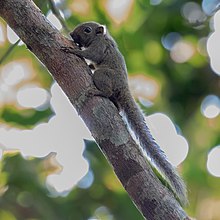Microsciurus
| Microsciurus | |
|---|---|

| |
| Microsciurus flaviventer | |
| Scientific classification | |
| Domain: | Eukaryota |
| Kingdom: | Animalia |
| Phylum: | Chordata |
| Class: | Mammalia |
| Order: | Rodentia |
| Family: | Sciuridae |
| Subfamily: | Sciurinae |
| Tribe: | Sciurini |
| Genus: | Microsciurus J. A. Allen, 1895 |
| Type species | |
| Sciurus alfari J. A. Allen, 1895
| |
| Species | |
|
See text | |
Microsciurus[1] or dwarf squirrels is a genus of squirrels from the tropical regions of Central and South America.
Taxonomy and systematics
[edit]Recent DNA analysis has shown that there is some confusion regarding the traditional classification of the species in the genus Microsciurus,[2] and that the genus may be polyphyletic.[3] Currently, there are four species recognized:
- Central American dwarf squirrel (Microsciurus alfari) Allen, 1895, Costa Rica, Nicaragua, Panama, northern Colombia
- Amazon dwarf squirrel (Microsciurus flaviventer) Gray, 1867, western Amazon basin
- Western dwarf squirrel (Microsciurus mimulus) Thomas, 1898, Ecuador, Colombia, Panama
- Santander dwarf squirrel (Microsciurus santanderensis) Hernández-Camacho, 1957, central Colombia
A 2020 paper published on the taxonomy of Sciurinae split Microsciurus into three genera, one currently unnamed. The paper included genetic sampling from all species except Santander dwarf squirrel and (Microsciurus) simonsi. It suggests several new species, not all described.[4]
- Microsciurus
- Central American dwarf squirrel, M. alfari
- Microsciurus "species 1" from Colombia
- Leptosciurus
- Western dwarf squirrel, L. mimulus
- Andean squirrel, L. pucheranii (moved from Sciurus)
- Leptosciurus similis
- Leptosciurus otinus
- Leptosciurnus boquetensis
- Leptosciurus isthmius
- "Microsciurus"
- Amazon dwarf squirrel, "M." flaviventer
- "Microsciurus" sabanillae
- "Microsciurus" "species 2" from Peru and Brazil (previously assigned to Syntheosciurus)
Description
[edit]With a typical head-and-body length of about 15 cm (5.9 in) and a 12 cm (4.7 in) long tail, dwarf squirrels are relatively small. However, the Neotropical pygmy squirrel, not in this genus, is much smaller than these species, as are certain squirrels in Africa and Asia. Microsciurus species have gray or brown backs, and white bellies.
Distribution and habitat
[edit]All dwarf squirrels in this genus live in tropical rain forests. Estimates of their abundance are limited.[5] The IUCN lists the conservation status as "Least Concern" for three of the species and "Data Deficient" for Microsciurus santanderensis.[6]
References
[edit]- ^ Thorington, R.W. Jr; Hoffman, R.S. (2005). "Genus Microsciurus". In Wilson, D.E.; Reeder, D.M (eds.). Mammal Species of the World: A Taxonomic and Geographic Reference (3rd ed.). Johns Hopkins University Press. pp. 757–758. ISBN 978-0-8018-8221-0. OCLC 62265494.
- ^ Amori, G.; Koprowski, J. & Roth, L. (2008). "Microsciurus santanderensis". IUCN Red List of Threatened Species. 2008: e.T13412A3904007. doi:10.2305/IUCN.UK.2008.RLTS.T13412A3904007.en. Retrieved 12 January 2018.
- ^ Pečnerová, P. & Martínková, N. (February 2012). "Evolutionary history of tree squirrels (Rodentia, Sciurini) based on multilocus phylogeny reconstruction". Zoologica Scripta. 41 (3): 211–219. doi:10.1111/j.1463-6409.2011.00528.x. S2CID 86487063.
- ^ De Abreu-Jr, Edson Fiedler; Pavan, Silvia E.; Tsuchiya, Mirian T. N.; Wilson, Don E.; Percequillo, Alexandre R.; Maldonado, Jesús E. (2020). "Museomics of tree squirrels: A dense taxon sampling of mitogenomes reveals hidden diversity, phenotypic convergence, and the need of a taxonomic overhaul". BMC Evolutionary Biology. 20 (1): 77. Bibcode:2020BMCEE..20...77D. doi:10.1186/s12862-020-01639-y. PMC 7320592. PMID 32590930.
- ^ Jessen, T.G.; et al. (August 2016). "Microsciurus flaviventer (Rodentia: Sciuridae)". Mammalian Species. 48 (935): 59–65. doi:10.1093/mspecies/sew006.
- ^ "The IUCN Red List of Threatened Species". IUCN Red List of Threatened Species. Retrieved 2020-05-15.
Bibliography
[edit]- Ronald M. Nowak: Walker's Mammals of the World. Johns Hopkins University Press, 1999 ISBN 0-8018-5789-9






